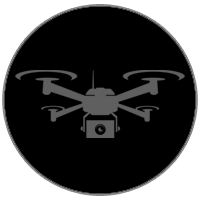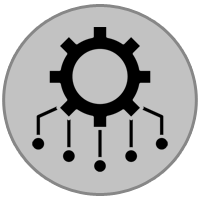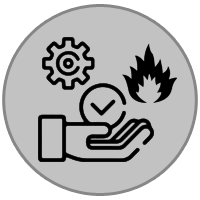SURVEILLANCE / FIRE FIGHT Control Center
The Heart of Emergency Response
The Firefighting Control Center is a critical hub of coordination and response in emergency services.
This state-of-the-art facility ensures every second counts during a fire emergency, providing firefighters with the tools and information they need to protect lives, property, and the environment effectively.
At the core of modern fire management, the control centre integrates advanced technology, real-time data, and strategic operations, making it an indispensable asset in firefighting efforts.
The Functionality of a Firefighting Control Center
A firefighting control center is a command and control hub where emergency operations are monitored and managed.
It is equipped with sophisticated technology to handle various aspects of fire emergency management:
Real-Time Monitoring: The control center is equipped with multiple large screens displaying live feeds from surveillance cameras, drones, and other monitoring devices. This real-time footage provides a comprehensive view of the situation, allowing for swift decision-making and resource allocation.
Advanced Communication Systems: Effective communication is paramount during emergencies. The control center utilizes high-tech communication equipment, including radios, intercoms, and satellite phones, ensuring seamless communication between firefighters on the ground and command personnel.
Data Integration and Analysis: The center integrates data from various sources, such as weather updates, geographical information systems (GIS), and building layouts. This information is crucial for predicting fire behavior, planning evacuation routes, and deploying resources efficiently.
Coordination and Resource Allocation: The control center plays a pivotal role in coordinating the response efforts of different fire units and other emergency services. It ensures that the right personnel and equipment are dispatched promptly to the right locations.
Incident Management: A digital board in the control center tracks ongoing incidents, resource deployment, and operational status. This helps in maintaining an organized approach to managing multiple emergencies simultaneously.
1. Fire Measurement
Purpose: To accurately quantify and characterize fires, enabling a better understanding of their behavior and aiding in effective prediction and management.
Technologies and Methods:
- Remote Sensing: Utilization of satellite imagery and aerial photography for fire detection, spread analysis, and intensity assessment.
- Thermal Imaging Cameras: Deployed with first responders to visualize heat signatures through smoke and identify critical hotspots.
- GIS Mapping: Geographic Information Systems facilitate real-time mapping of fire perimeters and predictive modeling based on terrain, fuel type, and meteorological data.
Key Metrics:
Fire Size & Perimeter: Typically measured in acres or square kilometers.
Heat Intensity: Captured through thermal sensors to evaluate fire severity.
Rate of Spread: Assessed based on wind speed, vegetation type, and terrain.
Challenges:
- Limited accessibility in remote regions.
- Potential inaccuracies in real-time data collection.
Opportunities for Improvement:
- Advancements in satellite and UAV-based sensors.
- Integration of multiple data sources into unified, real-time platforms.
2. Fire Watching
Purpose: To ensure early detection of wildfires, enabling swift response and minimizing environmental and infrastructural damage.
Technologies and Methods:
- Watch Towers: Strategically located and staffed for constant visual monitoring.
- Drones & Manned Aircraft: Equipped with high-resolution and infrared cameras for aerial surveillance.
- Satellite Monitoring: Detection of thermal anomalies and hotspots in inaccessible areas.
Implementation Strategies:
- 24/7 Monitoring: Particularly during high-risk seasons.
- Centralized Data Integration: Aggregating inputs from all surveillance systems into a unified command center.
Challenges:
- High operational costs.
- Weather-related visibility limitations.
Opportunities for Improvement:
- AI-based anomaly detection from real-time surveillance feeds.
- Community engagement through mobile reporting tools and citizen watch programs.
3. Fire Control
Purpose: To contain, manage, and ultimately extinguish wildfires to prevent escalation and further damage.
Techniques:
Controlled Burns: Prescribed fires to eliminate potential fuel in a managed environment.
Firebreaks: Vegetation-free zones acting as natural barriers to halt fire progression.
Chemical Retardants: Aerial or ground deployment to slow fire intensity and spread.
Challenges:
- Difficult terrain hindering accessibility.
- Optimal allocation of firefighting resources.
Opportunities for Improvement:
- Development of drone-based firefighting tools.
- Cross-agency standardized training for cohesive field operations.
4. Fire Defense
Purpose: To safeguard human life and infrastructure through proactive measures, structural reinforcement, and comprehensive emergency planning.
Key Strategies:
Community Education Programs: Promoting awareness, prevention techniques, and evacuation readiness.
Structural Fortification: Incorporating fire-resistant materials and maintaining defensible zones around properties.
Emergency Response Plans: Predefined and regularly rehearsed action plans for swift evacuation and fire response.
Logistical Requirements:
- Ongoing firefighter and civilian training exercises.
- Regular maintenance and readiness checks of fire defense equipment and vehicles.
Challenges:
- Inconsistent community preparedness.
- Complex logistics in equipment distribution and deployment.
Opportunities for Improvement:
- Broader adoption of innovative, fire-resistant construction techniques.
- Incentivized public participation in local defense initiatives.
- Integration and Coordination
Purpose:
To ensure seamless collaboration between all stakeholders involved in fire management—governmental agencies, emergency services, and local communities.
Core Components:
- Unified Command System (UCS): Centralized management structure coordinating all facets of emergency response.
- Real-Time Communication Networks: Data-sharing platforms enabling rapid exchange of information between agencies.
Challenges:
- Fragmentation of data across multiple platforms.
- Communication barriers due to differing terminologies and procedures.
Opportunities for Improvement:
- Centralized Data Hubs: Real-time, multi-agency access to fire-related data for coordinated decision-making.
- Joint Drills & Cross-Training: Regular exercises to harmonize inter-agency collaboration.
Conclusion
Effective forest fire management is multifaceted, requiring continuous evolution of tools, policies, and partnerships.
Each pillar - Measurement, Watching, Control, Defense, and Coordination - must be reinforced through:
- Technological Advancement
- Robust Policy Frameworks
- Community Engagement & Training
By enhancing these core areas, stakeholders can significantly improve responsiveness, reduce damage, and adapt to the increasing risks posed by climate change and human activity.
Fire management strategies in forest environments
The Role of Technology
The integration of cutting-edge technology is a defining feature of modern firefighting control centers.
Drones, equipped with thermal imaging cameras, provide aerial views and help in locating hotspots that are not visible from the ground. Advanced software systems analyze real-time data, offering predictive analytics to foresee the spread of the fire and potential risks.
This technological advantage allows firefighters to stay ahead of the fire, minimizing damage and enhancing safety.
Importance of a Well-Organized Control Center
A well-organized firefighting control center is the backbone of an effective emergency response system.
It ensures that every team member is aware of their role and has access to the necessary information and tools.
The layout of the center is designed to facilitate efficient workflow and quick access to critical data.
Bright lighting, ergonomic furniture, and strategically placed equipment contribute to a focused and alert work environment, essential for managing high-stress situations.
Conclusion
In conclusion, the Firefighting Control Center is an indispensable element in the architecture of fire emergency management.
It embodies the fusion of technology, strategy, and coordination, ensuring that every fire emergency is handled with precision and efficiency. As we continue to face the challenges posed by urbanization and climate change, the importance of these control centers in safeguarding our communities cannot be overstated.
Through continuous innovation and dedication, we strive to enhance our capabilities, providing superior fire protection and emergency response services.
For more information on our firefighting control center and the services we offer, please explore our website or contact us directly. Together, we can build a safer future.
Creating a firefight control center involves several critical components and steps to ensure effective command, control, and coordination during firefighting operations.
Here’s a comprehensive guide of what is needed for the fire fighting control center:
1. Infrastructure
Building and Location:
- A secure, accessible building located strategically to provide an optimal vantage point for overseeing operations.
- Reinforced construction to ensure safety and resilience during emergencies.
Facilities:
- Command rooms equipped with advanced communication and monitoring systems.
- Conference rooms for briefings and strategy meetings.
- Secure data and server rooms.
2. Technology and Equipment
Communication Systems:
- Reliable radio communication systems with multiple channels.
- High-speed internet and secure network infrastructure.
- Satellite phones and other emergency communication devices.
Monitoring and Control Systems:
- Advanced software for real-time tracking and management of firefighting resources.
- GIS (Geographic Information System) for mapping and spatial analysis.
- Video walls and large display screens for monitoring live feeds and maps.
- Surveillance cameras, drones, and UAVs for real-time aerial views.
Data Management:
- Robust servers and data storage solutions.
- Backup power systems to ensure continuous operation.
- Cybersecurity measures to protect sensitive data.
3. Personnel
Command and Control Staff:
- Experienced command staff with expertise in firefighting operations.
- Technical support staff for managing communication and IT systems.
- GIS specialists for handling spatial data and mapping.
Operational Staff:
- Dispatchers to manage communication with field teams.
- Analysts to interpret data and provide actionable insights.
- Administrative support for logistics and documentation
4. Procedures and Protocols
Standard Operating Procedures (SOPs):
- Clearly defined SOPs for different types of firefighting scenarios.
- Emergency response protocols for coordination with other agencies.
Training Programs:
- Regular training for all staff on the latest technologies and procedures.
- Simulation exercises to prepare for various emergency situations.
Coordination Mechanisms:
- Established communication lines with local, regional, and national emergency services.
- Integration with other emergency management systems and services.
5. Logistics and Support
Resource Management:
- Inventory management system for tracking firefighting equipment and supplies.
- Fleet management system for vehicles and machinery.
Facilities Support:
- Maintenance teams to ensure all equipment and facilities are in optimal condition.
- Catering and rest areas for staff during prolonged operations.
Health and Safety:
- Medical facilities and first aid stations.
- Safety protocols to protect staff from hazards.
6. Legal and Regulatory Compliance
Licensing and Permits:
- Compliance with local, national, and international regulations.
- Necessary permits for operating communication systems and surveillance equipment.
Insurance:
- Comprehensive insurance coverage for the center, equipment, and personnel.
7. Funding and Budgeting
Financial Planning:
- Detailed budgeting for initial setup and ongoing operations.
- Funding sources, including government grants, private investments, and partnerships
Benefits of Using Unmanned Aerial Vehicles (UAVs) for Fire Surveillance
Early Detection and Response: UAVs equipped with thermal imaging sensors play a crucial role in the early detection of fires.
These sensors can detect abnormal heat patterns and heat sources that may be indicative of a fire starting, even in remote or inaccessible areas.
Upon detecting a potential fire, UAVs can immediately alert command centers, allowing for rapid deployment of firefighting resources.
The ability to detect fires early significantly reduces the spread and potential damage, helping to contain fires more efficiently and preventing them from becoming larger, uncontrollable blazes.
Real-Time Monitoring and Tactical Support: During a fire, UAVs provide invaluable real-time data and visuals to firefighting teams.
By streaming live video feeds, UAVs offer a bird’s-eye view of the fire, revealing its size, spread, and the effectiveness of firefighting efforts.
This aerial perspective helps commanders make informed decisions about where to deploy resources and how to approach containment. UAVs can also identify hotspots and areas where the fire might spread next, allowing firefighters to preemptively position themselves to contain these potential threats.
Assessment and Damage Control Post-Fire: After a fire has been controlled or extinguished, UAVs continue to be a critical tool for firefighting teams.
They can be deployed to conduct thorough scans of the affected area for any remaining hotspots that could reignite.
UAVs also assist in the damage assessment process by providing detailed images and data of the affected areas, which is essential for evaluating the impact of the fire and planning recovery efforts.
This post-fire surveillance ensures that all fire pockets are completely extinguished and helps in documenting the extent of the damage for insurance and investigative purposes.
Safety and Efficiency: The use of UAVs enhances the safety of firefighting personnel by reducing the need to send humans into dangerous, unstable conditions to assess or monitor fire situations.
By utilizing UAVs, firefighting teams can maintain a safe distance, yet have access to detailed, actionable data that would be risky and time-consuming to gather by traditional means.
This not only keeps firefighters safer but also improves the overall efficiency of firefighting operations, allowing teams to focus their efforts where they are most needed without unnecessary risk.
Conclusion
The integration of UAVs into fire surveillance and management systems significantly enhances the capabilities of firefighting teams, from early detection and real-time tactical support to post-fire assessment and recovery planning.
These technologies ensure faster response times, improved decision-making, enhanced firefighter safety, and ultimately, more effective fire management. By adopting UAV technology, firefighting units can leverage these benefits to improve their operational outcomes and reduce the impact of fires on communities and the environment.









